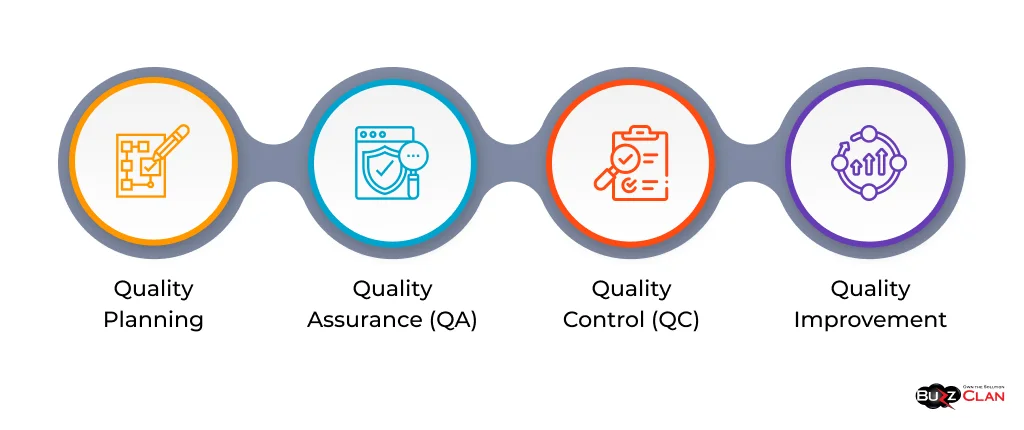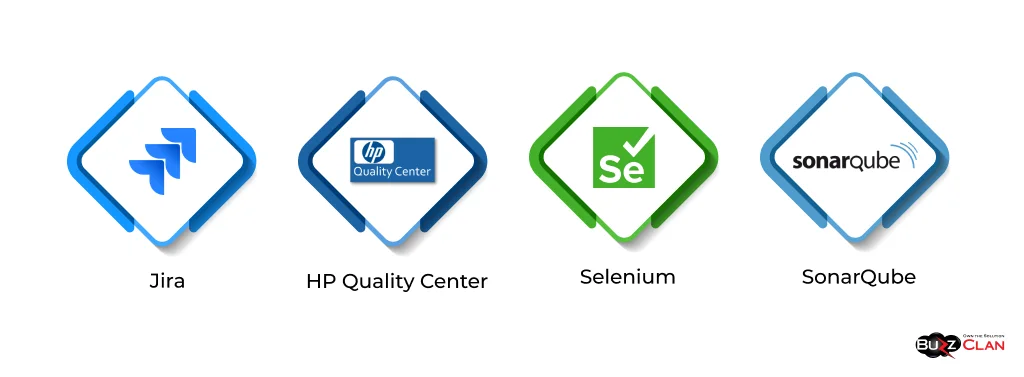The Ultimate Guide to Software Quality Management Best Practices
Deepak Desai
Apr 23, 2024
Introduction
Software Quality Management (SQM) systematically ensures that software products and services meet and exceed customer expectations. It encompasses various activities, processes, and methodologies to maintain and improve software quality throughout its development lifecycle. SQM plays a crucial role in the success of software projects, as it helps to identify and prevent defects, reduce development costs, and enhance customer satisfaction.
In today's competitive market, software quality is a critical differentiator. Companies prioritizing quality are more likely to succeed in the long run, as they can deliver reliable, high-performing software products that meet their customers' evolving needs. As such, SQM has become an integral part of the software development process, and its significance cannot be overstated.
Core Elements of Software Quality Management
SQM comprises several core elements that work together to ensure the quality of software products. These elements include:

- Quality Planning: This involves defining quality objectives, standards, and metrics, as well as identifying the resources and processes needed to achieve them.
- Quality Assurance (QA): QA encompasses all activities to ensure software products meet the specified requirements and standards. This includes testing, code reviews, and audits.
- Quality Control (QC): QC involves monitoring and measuring the quality of software products against the defined standards and taking corrective action when necessary.
- Quality Improvement: This involves continuously seeking ways to improve the quality of software products and processes based on feedback and lessons learned.
SQM integrates with software development by establishing quality gates at various lifecycle stages. These gates serve as checkpoints to ensure quality standards are met before proceeding to the next stage. For example, a quality gate at the end of the design phase might involve reviewing the software architecture to ensure it meets the specified requirements and is feasible to implement.
Roles and Responsibilities in an SQM Team
An SQM team typically consists of several roles, each with specific responsibilities. These roles include:
| Roles | Description |
|---|---|
| Quality Manager | Responsible for overseeing the entire SQM process, defining quality objectives and standards, and ensuring they are met. |
| QA Engineer | This person is responsible for developing and executing test plans, identifying defects, and ensuring they are resolved. |
| QC Analyst | This position is responsible for monitoring and measuring the quality of software products against the defined standards and reporting on quality metrics. |
| Process Improvement Specialist | Responsible for identifying opportunities for process improvement and implementing changes to enhance quality. |
| Tools and Automation Specialist | Responsible for identifying and implementing tools and automation solutions to streamline the SQM process. |
SQM in Software Engineering and Testing
SQM is closely related to software engineering and testing. Software engineering involves applying engineering principles to software product design, development, and maintenance. SQM supports software engineering by ensuring quality is built into the product from the outset rather than being an afterthought.
Software testing is a critical component of SQM. It involves verifying that software products meet the specified requirements and identifying defects that must be resolved. SQM helps ensure that testing is planned and executed effectively and defects are identified and resolved promptly.
SQM and Continuous Integration
Continuous Integration (CI) is a software development practice that involves regularly merging code changes into a shared repository and automatically building and testing the software. CI helps to maintain software quality by catching defects early in the development process before they have a chance to propagate and become more difficult and costly to resolve.
SQM supports CI by establishing quality gates automatically enforced as part of the CI process. For example, a quality gate might require that all unit tests pass before code changes can be merged into the main branch. This helps ensure that the software remains relevant and that quality is maintained throughout development.
Risks and Quality: The Management Perspective
Risk management is a critical aspect of SQM. Software projects are inherently risky, as they involve complex systems, changing requirements, and tight deadlines. SQM helps to identify and manage these risks by establishing processes for identifying, assessing, and mitigating potential quality issues.
Techniques for managing risks in software projects include:
| Techniques | Description |
|---|---|
| Risk Identification | This involves identifying potential risks to software quality, such as changing requirements, technical complexity, or resource constraints. |
| Risk Assessment | This involves assessing the likelihood and impact of identified risks and prioritizing them based on their potential impact on software quality. |
| Risk Mitigation | This involves developing and implementing strategies to mitigate identified risks, such as increasing testing efforts, allocating additional resources, or adjusting project schedules. |
| Risk Monitoring | This involves continuously monitoring risks throughout the project lifecycle and taking corrective action as needed. |
SQM Tools and Applications
There are many tools and applications available to support SQM activities. These tools help to automate and streamline various aspects of the SQM process, such as test case management, defect tracking, and quality metrics reporting.
Popular SQM tools include:

- Jira: A project management and issue-tracking tool that helps teams to plan, track, and release software.
- HP Quality Center: A comprehensive quality management solution supporting requirements, testing, and defect management.
- Selenium: An open-source tool for automating web application testing.
- SonarQube: A platform for continuously inspecting code quality and security.
These tools can be integrated with other enterprise systems, such as configuration management databases (CMDBs) and IT service management (ITSM) platforms, to provide a holistic view of software quality across the organization.
Measuring Success: Key Performance Indicators for SQM
Measuring the success of SQM efforts requires establishing key performance indicators (KPIs) that align with organizational goals and objectives. Some common KPIs for SQM include:
- Defect Density: The number of defects per code unit, such as per thousand lines of code (KLOC).
- Defect Escape Rate: The percentage of defects not caught by the testing process and making it into production.
- Mean Time to Detect (MTTD): The average time it takes to identify a defect after it is introduced into the system.
- Mean Time to Resolve (MTTR): The average time it takes to resolve a defect after its identification.
- Customer Satisfaction: Measured through surveys or other feedback mechanisms, this KPI provides insight into how well the software meets customer needs and expectations.
Tools for tracking and reporting on these KPIs include software quality dashboards, which provide real-time visibility into key quality metrics, and analytics platforms that enable deeper analysis and insights into quality trends over time.
The Role of a Software Quality Assurance Manager
A Software Quality Assurance Manager oversees the SQM process and ensures that quality standards are met. Some of the key activities and responsibilities of this role include:
- Defining and implementing quality standards, processes, and procedures.
- Planning and coordinating QA activities like testing and code reviews.
- Manage the QA team and ensure they have the necessary skills and resources to perform their roles effectively.
- Collaborating with other stakeholders, such as developers, project managers, and business analysts, ensures that quality is integrated throughout the software development lifecycle.
- Reporting on quality metrics and status to senior management and other stakeholders.
To be effective in this role, a Software Quality Assurance Manager should have a strong technical background, excellent communication and leadership skills, and a deep understanding of SQM principles and practices.
Challenges in Software Quality Management
Despite the many benefits of SQM, there are also several challenges that organizations may face when implementing and maintaining an effective SQM program. Some common challenges include:
- Lack of management support: SQM requires a significant investment of time, resources, and effort, and strong management support is necessary to implement and maintain an effective program.
- Resistance to change: Implementing SQM often requires changes to existing processes and practices, which can be met with resistance from team members who are comfortable with the status quo.
- Inadequate resources: SQM activities, such as testing and code reviews, can be time-consuming and resource-intensive, and with adequate resources, maintaining a high level of quality can be easy.
- Rapidly changing technologies and requirements: As software systems become more complex and customer requirements evolve rapidly, keeping up with the pace of change while maintaining quality standards can be difficult.
To overcome these challenges, organizations should take a proactive approach to SQM, investing in the necessary resources and tools, providing training and support to team members, and continuously monitoring and improving their SQM processes and practices. Case studies of successful SQM implementations can provide valuable insights and best practices for overcoming common challenges.
Future of SQM: Trends and Predictions
As software systems continue to evolve and become more complex, the future of SQM is likely to be shaped by several key trends and predictions, including:
- Increased focus on automation: As the volume and complexity of software systems continue to grow, organizations will increasingly rely on automation to support SQM activities, such as testing and code analysis.
- Shift-left testing: Organizations will continue to shift testing activities earlier in the software development lifecycle to catch defects and quality issues as early as possible.
- Continuous testing: As organizations adopt DevOps and continuous delivery practices, continuous testing will become increasingly important to ensure that software quality is maintained throughout development.
- AI and machine learning: AI and machine learning technologies will increasingly support SQM activities, such as predictive analytics and defect detection.
- Focus on user experience: As customer expectations rise, organizations will emphasize user experience and usability testing to ensure that software products meet end-user needs and expectations.
Choosing the Right SQM Software
Choosing the right SQM software is critical to the success of an SQM program. When evaluating SQM software options, organizations should consider several key criteria, including:
- Functionality: The software should support the full range of SQM activities, from requirements and test case management to defect tracking and reporting.
- Ease of use: The software should be intuitive and easy to use, with a user-friendly interface and clear documentation.
- Integration: The software should integrate seamlessly with other tools and systems used in the software development process, such as issue tracking and continuous integration/continuous delivery (CI/CD) pipelines.
- Scalability: The software should be able to scale to support the organization's needs as it grows and evolves.
- Customization: The software should be customizable to meet the specific needs and requirements of the organization.
Some top SQM software options available today include Jira, HP Quality Center, and IBM Rational Quality Manager. Organizations should carefully evaluate their options and choose a solution that best meets their needs and budget.
Implementing a Quality Management System in Software Testing
Implementing a quality management system (QMS) in software testing involves integrating quality management principles and practices into the testing process. Some key steps in implementing a QMS in software testing include:
- Define quality objectives: Clearly define the quality objectives for the software testing process, including the desired level of defect detection and the target level of customer satisfaction.
- Establish quality policies and procedures: Develop and document quality policies and procedures for the software testing process, including testing methodologies, test case design, and defect management.
- Implement quality control activities: Implement quality control activities, such as code reviews and testing, to ensure that software products meet the defined quality objectives.
- Monitor and measure quality: Continuously monitor and measure the quality of the software testing process using metrics and KPIs, such as defect density and test coverage.
- Continuously improve: Based on feedback and lessons learned, continuously seek opportunities to improve the quality of the software testing process.
Implementing a QMS in software testing can provide significant benefits, including:
| Benefits | Challenges |
|---|---|
| Increased efficiency | By establishing clear quality policies and procedures, organizations can streamline the testing process and reduce the time and effort required to achieve high levels of quality. |
| Improved defect detection | By implementing rigorous quality control activities, such as code reviews and testing, organizations can improve their ability to detect and resolve defects early in the software development lifecycle. |
| Enhanced customer satisfaction | Organizations can enhance customer satisfaction and loyalty by ensuring that software products meet customers' needs and expectations. |
| Reduced costs | Organizations can reduce software development and maintenance costs by catching defects early and reducing the need for rework and maintenance. |
Conclusion
In conclusion, software quality management is a critical component of software development, essential for delivering high-quality software products that meet customers' needs and expectations. Organizations can reduce defects, improve efficiency, and enhance customer satisfaction by implementing a comprehensive SQM program that includes quality planning, assurance, control, and improvement.
To succeed, SQM programs require a strong commitment from management, adequate resources and tools, and a quality culture permeating the entire organization. Organizations can stay ahead of the curve and deliver reliable, secure, and user-friendly software products by adopting best practices in SQM, such as shift-left testing, continuous testing, and automation.
As the software industry continues to evolve and new technologies emerge, the importance of SQM will only continue to grow. Organizations that prioritize quality and invest in effective SQM programs will be well-positioned to succeed in the highly competitive software market of the future.
FAQs

Get In Touch
